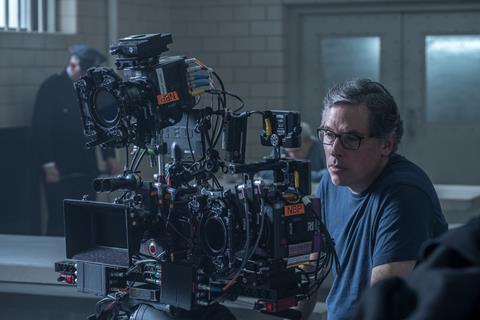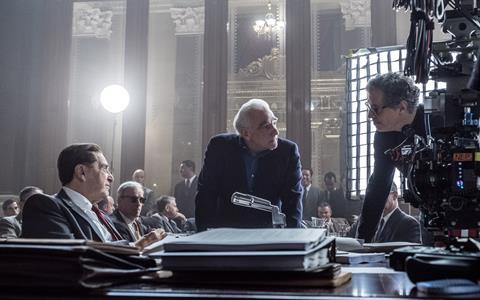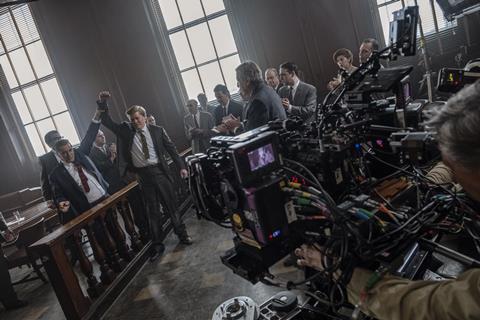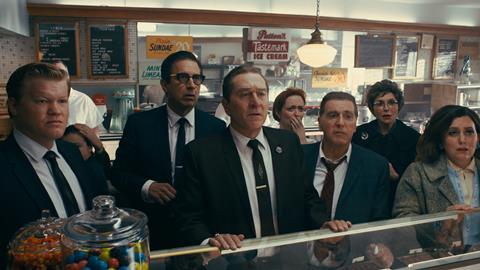Martin Scorsese’s new crime drama sees the Goodfellas director reunite with Robert De Niro. Adrian Pennington spoke to Rodrigo Prieto about shooting a tale that spans six decades.

Martin Scorsese returns to organised crime in an epic feature which could last a mini-series and is all about time.
“It is an essential part of what the movie is about,” says Rodrigo Prieto, ASC. “How time affects us as human beings and how we relate to the story of our lives.”
Specifically, The Irishman is recollected by Frank Sheeran (Robert De Niro), World War II veteran turned trade union enforcer and mob associate in a tale spanning six decades and a movie time of 209 minutes.
“One of the first things Scorsese and I talked about was memory and how we could portray that,” Prieto tells IBC365. “Scorsese mentioned home movies as a reference but we didn’t want to film as a home movie so I started exploring amateur stills photography as a way to convey the passage of decades.”
While Super 8 and 16mm would have been the logical choice to achieve this look, the filmmakers didn’t want to make it handheld or too grainy, plus they had to account for the decision to use extensive VFX to de-age De Niro and some of the other principal actors.
“We decided we had to shoot digital for the scenes that required de-ageing and use negative the rest of the time,” he says. “I talked with VFX Supervisor Pablo Helman and he assured me that they would be able to match the look of film with digital.”
- Read more: VFX: De-aging tech
Colour of nostalgia
Prieto spent considerable time researching, consulting with colour scientists and testing film stock to emulate the colours of old home photography.
“I was born in the sixties [1965] and my memories of the 1950s are evoked by the slide photography of my parents which was on Kodachrome,” he says. “I felt the look of Kodak’s Ektachrome was more appropriate for the 1960s.”
“The crux of the story happens primarily in the 1970s so I decided to base the look here on a film developing technique first made by Technicolor in Italy. It’s a process in which you skip the bleaching of the print and keep some of the silver on it to create an image with more contrast and less colour.”

The editorial idea is that The Irishman begins with the nostalgic saturated colours of Kodachrome (“the reds pop”) and as the film unfolds it transitions (“to more of a blue-green palette”), gradually more colour is taken away from the image to signify the draining of hope.
Prieto worked with digital workflow developer Codex and facility Harbor Picture Company to design a lookup table to map the colours shot on 35mm to digital. A second step was adding in grain to match the film’s emulsion. In the process, he concluded that Red Helium cameras shooting 8K offered the best means of emulating the analogue look.
Hydra cam
About half of The Irishman is shot digitally and half on ARRI film cameras, with the digital scenes requiring the design of a new camera rig comprising two Alexa Minis on either side of the Red to feed data into the VFX pipeline.
All three cameras for each angle had to move in unison and have their shutter’s synchronised. The rig had to be lightweight enough for all the cameras to fit on one head. None of that would have been possible using film cameras with magazines that needed loading and unloading.

The ‘hydra’ rig also had to be fitted to different heads – a crane, remote head or fluid head. “We wanted to be sure Scorsese was not limited in any way in the design of shots,” Prieto says. “We failed the first time. After some trial and error, new motors and more lightweight materials we got there.”
Scorsese prefers to shoot dialogue scenes from two camera angles simultaneously – one over the shoulder of the actor and vice-versa – which gave Prieto the challenge of hiding cameras that were facing each other in shot.
“If I were to do this again, I’d look for a rig where the cameras are lighter and as small as possible,” says Prieto. “Sometimes we’d have a third angle which meant nine cameras rolling at the same time – which means a much larger crew including a focus puller for each camera. It’s a big investment.”
Instead of helmets or physical tracking markers, the actor’s faces were painted with infrared make-up which the two witness cameras could ‘see’. Additional volumetric information about each scene came from a Lidar scan.
“VFX had all this information to compute the position and intensity of light and even the reflectivity off the sets to apply to the facial de-ageing. They didn’t have to rebuild the light for each scene, it was kind of an automatic process.”

Having lensed Scorsese’s previous two films The Wolf of Wall Street and Silence, the cinematographer has come to a good understanding of what the director wants.
“He writes notes on the script or diagrams sometimes also drawings about the compositions he has in mind,” Prieto explains. “He will give a sense of the energy, the mood or editorial motivation for certain parts of the movie. Within that, I can propose where the camera might be, what focal length to select, and how to light the shot.”
Blast from the past
It’s clear that The Irishman is as much a reminiscence for the director as it is for his central character. “He would talk about the Villa di Roma restaurant [where the movie opens] and [Italian seafood restaurant] Umberto’s Clam House as the type of places where men like these would meet and how he had vivid memories of these places growing up.”
At one point in the movie, Sheeran sets fire to a row of yellow Chicago cabs in a clear nod to Scorsese’s Taxi Driver. The casting of Joe Pesci and Harvey Keitel also unites the director with his earlier work, but stylistically the camera work and editing is more restrained than Casino or Goodfellas.
“This isn’t based on any limitations in the hydra rig,” Prieto wants to emphasise. “Scorsese constantly wanted to tell the story from Frank’s perspective. Frank is not a complicated man. He paints houses [murders] in a very methodological way so when we are with Frank the camera movement reflects this with simple pans that we might show repeated later. Scorsese used the term ‘clockwork’ to describe Frank’s routine. Even the cars are shown in perfect profile and sometimes the camera is just static.”
One of those shots is a close-up held on De Niro the moment he boards a small plane en route to perform a murder that even for Frank Sheeran might be above and beyond the call of duty.
“One of the privileges of a cinematographer is being right there a few feet from the energy of an actor giving their first performance. It’s more than a front-row seat in a theatre. You are participating in the moment. You are feeling it as you operate the camera. Watching through the eyepiece of a film camera is superior to watching on a calibrated monitor because everything – the costume, the production design, the virtuosity of the acting – is seen first through that lens and you are responsible for capturing it.
“In this case, De Niro doesn’t do much at all, outwardly. Frank is forced to go on the airplane. He knows what he is going to do and it’s horrendous for him but he also can’t show any nerves. He is swallowing all these emotions and you can feel this churning up inside. He is baring his soul in this moment. It was incredible to witness. Hopefully, that translates to screen.”

























No comments yet